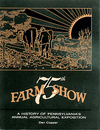History Page 4
The 1955 show honored the centennial of the founding of the Pennsylvania State University, whose College of Agriculture and Extension Service remain intimately involved in the Farm Show's operation. Each year the college and extension service dispatch more than a hundred staffers to help register and weigh animals, assist with press coverage and generally make the show a smoothly functioning event.
As the 1960s approached, the Farm Show complex was opened to even more uses. A portable basketball floor was acquired in 1959 for use in the Large Arena. Three governors - David L. Lawrence, William W. Scranton and Raymond P. Shafer - were inaugurated in the Large Arena. Governor Shafer hosted his inaugural ball in the Main Exhibition Building.
Probably the last bit of truly national attention the Farm Show garnered occurred in 1960, when Governor Lawrence fell off a milking stool while posing for photographers during the annual governor's preview tour. An unflattering photograph appeared the next morning in newspapers across America, including The New York Times. The affable - and unflappable - Lawrence took the incident good-naturedly, and said he was glad the incident had brought the Farm Show such widespread publicity.
The late 1960s and the 1970s brought turbulence and turmoil for the show and the buildings that housed it. Ceremonies marking the fiftieth anniversary show occurred in 1966, but about the same time, a long series of studies began that projected abandoning the Farm Show complex site and building a new exposition center on a three hundred acre site about a mile northeast of the complex. Times had changed, however, from the days when many state legislators were reared on farms (or farmed themselves) and harbored sympathetic support for agricultural projects. The new complex was proposed and duly debated time and again, but never passed the stage of an architectural rendering.
Two events within as many years confirmed that the Farm Show would remain put. In June 1972, Tropical Storm Agnes flooded the building even more severely than had the flood of 1936. The water damage was followed by a Pennsylvania Department of Labor and Industry inspection in early 1974 which uncovered many safety and structural deficiencies. State legislators decided to authorize major repairs and reconstruction, costing tens of millions of dollars, rather than opting for a new structure, which would cost a minimum of one hundred and fifty million dollars.
Many other aspects of the Farm Show have changed over the course of time. No longer is there a horseshoe pitching contest or a log-sawing competition. The Rural Talent Festivals, in which hundreds of performers came together to sing and dance - without a single rehearsal - disappeared in 1957. Bans on poultry and swine have come and gone with the arrival and departure of Newcastle's disease, avian flu and hog cholera.
More shows held on at the facility have made the complex more self-supporting than at any time in its history. Farm Show crowds are not as large as those of the great postwar crush, but interest remains high. Prospective exhibitors face a five year wait for space because demand simply exceeds supply. Today the amount of premiums awarded to exhibitors totals nearly two hundred thousand dollars - a far cry from the $735 offered in 1917. New display areas highlight the importance of the food processing industry. Last year Farm Show officials announced plans for the construction of a new exhibition building between the Main Exhibition Building and the Large Arena, a structure that was purportedly approved during the administration of Gov. George Leader in the late 1950s.
Yet with all of these changes, the Farm Show still remains the "annual meeting-place of the farmer and city-dweller," as a newspaper described it in 1939. It remains central to the Keystone State's agricultural life and culture. So long as the auctioneer's gavel on Fridays of show week sounds the sale of grand champion baby beef, farm youth will be assured of college educations.
During dedication ceremonies for the original main building in 1931, Governor Fisher made an observation that has remained timeless - and timely. "This show," he said, "is the romance of Pennsylvania agriculture."
Dan Cupper of Harrisburg is a freelance writer and editor, whose special interests include the history of transportation, particularly railroading. His articles have appeared in American Heritage and Pennsylvania Magazine. He is the author of two books, The Pennsylvania Turnpike: A History & 75th Farm Show: A History of Pennsylvania's Annual Agricultural Exposition.
For Further Reading
 |
75th Farm Show: A History of Pennsylvania's Annual Agricultural Exposition by Dan Cupper Pennsylvania Historical and Museum Commission and Pennsylvania State Farm Products Show Commission 1991. |




